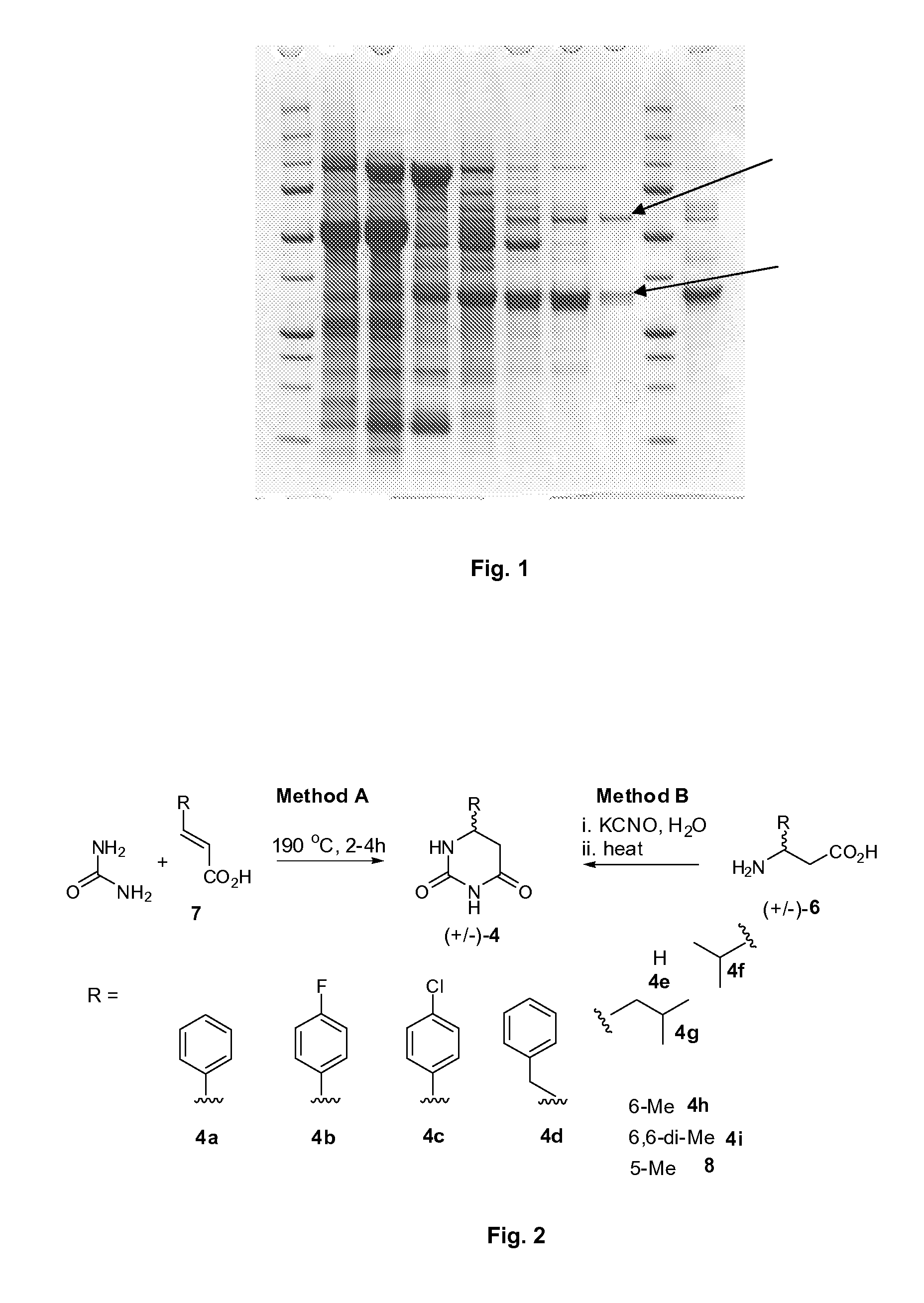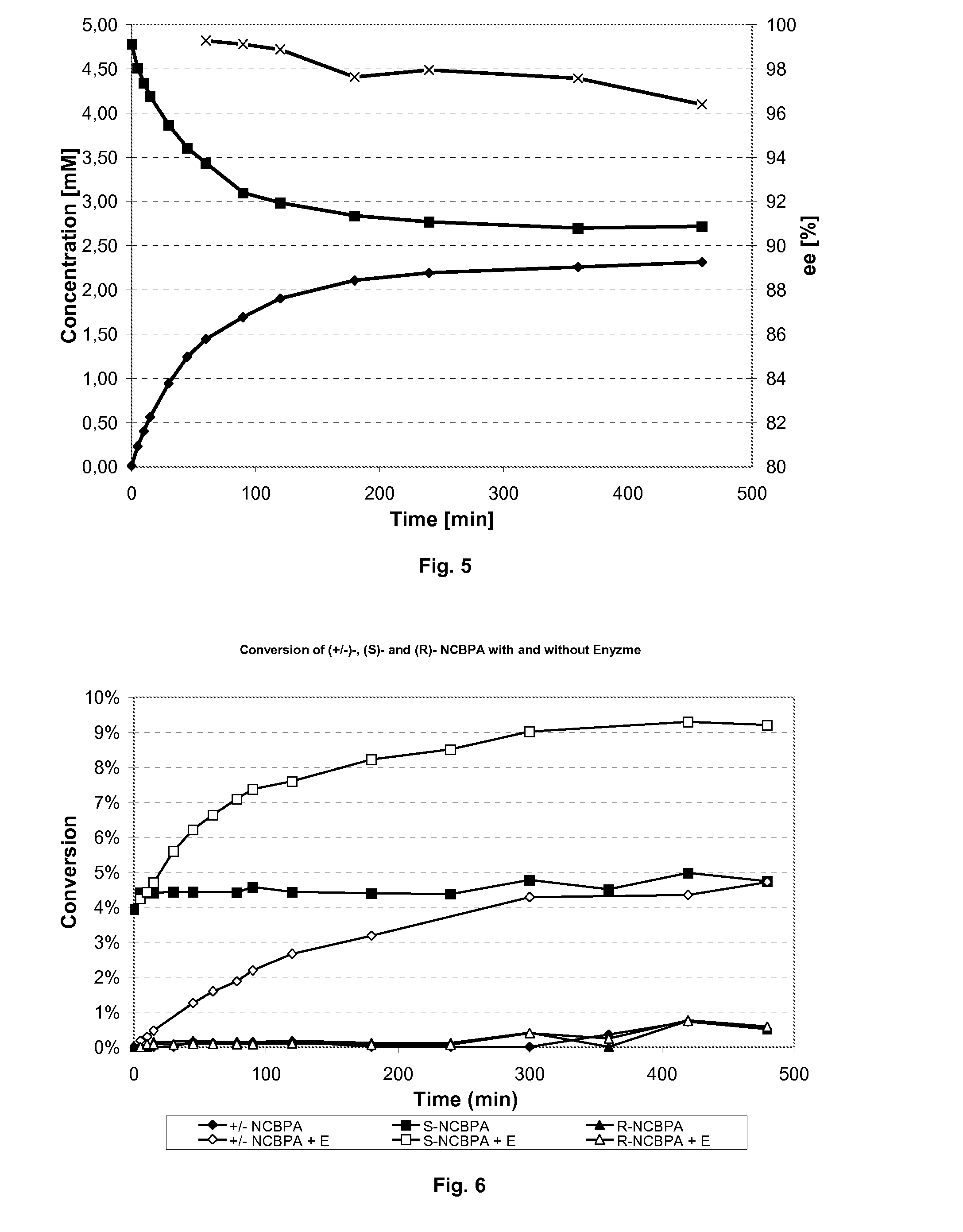Preparation of beta-amino acids
a technology of beta-amino acids and beta-amino acids, which is applied in the field of preparation of beta-amino acids, can solve the problems of not being universally applicable, and the yield of this type of reaction is only 50%
- Summary
- Abstract
- Description
- Claims
- Application Information
AI Technical Summary
Benefits of technology
Problems solved by technology
Method used
Image
Examples
example 1
Assays for Hydrolysis of 5-Substituted Hydantoin or 6-Phenyldihydrouracil
[0126]In order to determine hycantoinase activity, D-hydantoinase (10.5 mg) was added to 5-phenylhydantoin (1.32 mg) dissolved in borate buffer (1.5 mL, 0.1 M, pH 9.0). The biotransformation was incubated in an Eppendorf “Themomixer comfort”, (40° C., 1400 rpm). At given time points, aliquots (100 μL) of the mixture were taken and the reaction stopped by denaturing the enzyme and precipitating the soluble protein by addition of TCA, (12% w / v, 175 μL). After centrifugation the supernatant was collected and analysed by HPLC, wherein the following parameters were used:
Column: Agilent Zorbax XBD-C18 4.6 mm×50 mm, 3.5 μm.
Conditions: 25° C., 1 ml / min of H2O:acetonitrile, 85:15 (+0.1% TFA)
Retention times of 5-phenylhydantoin (3.6), N-carbamoyl-α-phenylglycine (2.7). The assay setup can be used to determine the hydantoinase activity of an enzyme suspected of having such activity by replacing D-hydantoinase by said enzy...
example 2
Isolation of a Hydantoinase from Vigna angularis
[0128]A protein with hydantoinase activity was isolated from Vigna angularis as follows:
2.1. Bean Extraction
[0129]885 g Adzuki beans (obtained from a health food store) were ground in two aliquots together with dry ice, using a conventional mixer. To the obtained bean powder 4 L extraction buffer (20 mM Tris, 10 mM ascorbic acid, 10 mM lysine, pH 7.5) was added, the suspension was stirred overnight at 4° C. filtered through gaze and centrifuged. 2500 mL crude extract with a protein content von 9.5. mg / ml were obtained and stored at −20° C. until subsequent chromatography steps (using chromatography columns from Amersham Pharmacia or GE Healthare) were performed.
2.2. Ion Exchange Chromatography (Q-Sepharose Fast Flow)
[0130]A Q-Sepharose FF-chromatography column (diameter: 5 cm; length: 21 cm) was washed with 200 mM Tris / HCl (pH 7.5), equilibrated with running buffer A (20 mM Tris / HCl, 1 mM ascorbic acid, 1 mM L-lysine*HCl, pH 7.5), and...
example 3
Activity Comparison Between Commercially Available Hyandantoinase and Isolated Hydantoinase
[0153]The activities of hydantoinase obtained from Sigma and hydantoinase isolated in Example 2 were compared.
[0154]To determine and compare the specific activity of the Sigma enzyme and the purified hydantoinase (BP) 5 mM of hydantoin, 5-phenylhydantoin or 6-phenyldihydrouracil, respectively, in 50 mM Tris HCl pH 7.5 were incubated with different amounts of enzyme for 30 min at 40° C.
[0155]The reaction was stopped by adding conc. HCl and then measured by HPLC.
[0156]The following Table 1 is showing the specific activities from the sigma enzyme and the enzyme isolated in Example 2. Both enzymes show the highest activity towards 5-phenylhydantoin followed by hydantoin.
TABLE 1Enzyme fromEnzyme fromSubstrateSigmaExample 2Hydantoin2174255-Phenylhydantoin2615576-Phenyldihydrouracil672
PUM
| Property | Measurement | Unit |
|---|---|---|
| temperature | aaaaa | aaaaa |
| temperature | aaaaa | aaaaa |
| temperature | aaaaa | aaaaa |
Abstract
Description
Claims
Application Information
 Login to View More
Login to View More - Generate Ideas
- Intellectual Property
- Life Sciences
- Materials
- Tech Scout
- Unparalleled Data Quality
- Higher Quality Content
- 60% Fewer Hallucinations
Browse by: Latest US Patents, China's latest patents, Technical Efficacy Thesaurus, Application Domain, Technology Topic, Popular Technical Reports.
© 2025 PatSnap. All rights reserved.Legal|Privacy policy|Modern Slavery Act Transparency Statement|Sitemap|About US| Contact US: help@patsnap.com



